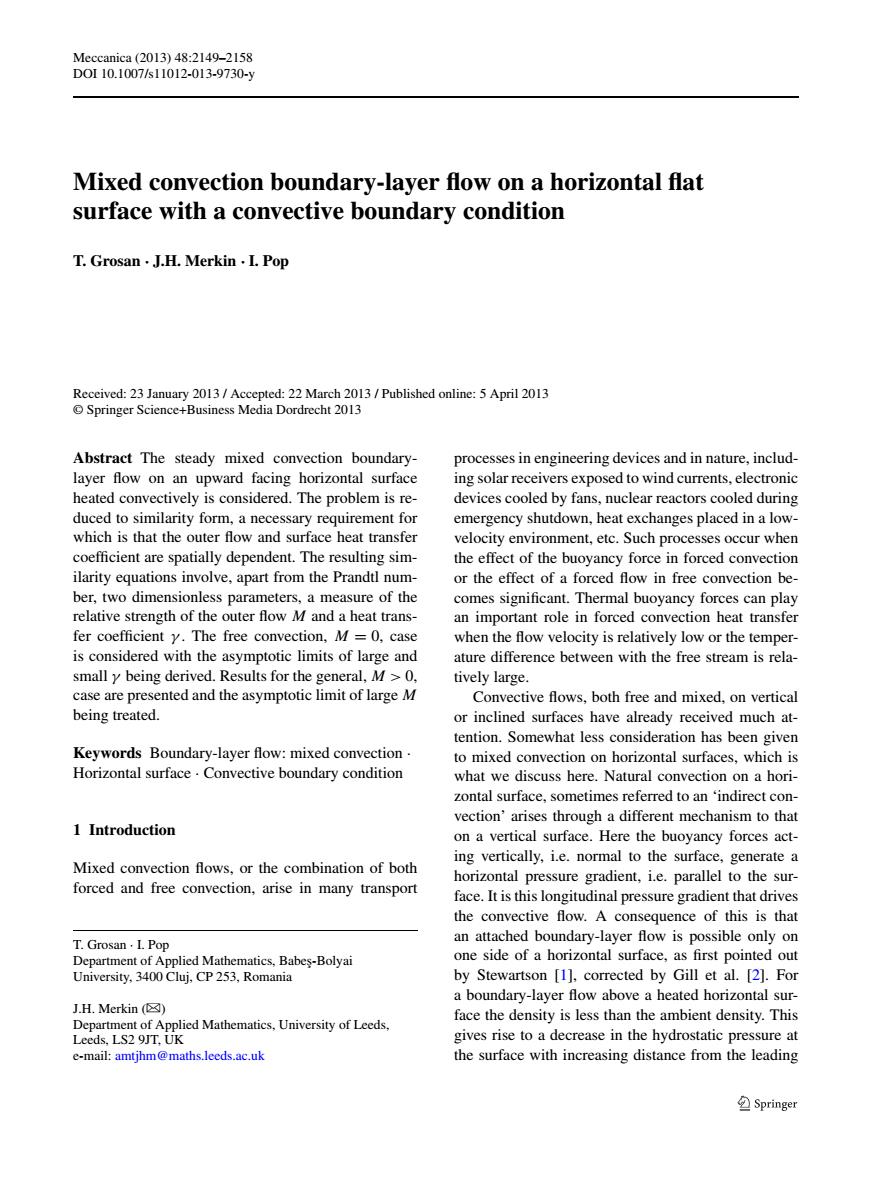正在加载图片...

6ia89o118a127958 amie20131482140215 Mixed convection boundary-layer flow on a horizontal flat surface with a convective boundary condition T.Grosan.J.H.Merkin.LPop cht 2013 Abstract The steady mixed conv vection boundary processes inengineering devices and innature,incud ayer flow on an upward rizon ng solar rec exposed to wind currents d to similarity form a necessary requirement for emergency shutdown.heat exchanges placed in a low which is that the outer flow and surface heat transfer velocity environment,etc.Such processes occur when coefficient are spatially dependent.The resulting sim- the effect of the buoyancy force in forced convection ilarity equations involve,apart from the Prandtl num or the effect of a forced flow in free convection be- ber,two dimensionless parameters,a measure of the comes significant.Thermal buoyancy forces can play relative strength of the outer flow M and a heat trans- an important role in forced convection heat transfer fer coefficient y.The free convection,M=0,case when the flow velocity is relatively low or the temper- is considered with the asymptotic limits of large and ature difference between with the free stream is rela- small y being derived.Results for the general,M>0. ively larg case are pre ented and the asymptotic limit of large M ctive flows,both free and mixed,on vertical being treated. or inclined surfac s have alr Somewhat less Keywords Boundary-layer flow:mixed conve to mixed convect ntal surface.Co nvective ion on horizontal surfaces,which is oundary conditior what we discuss here.Natural convection on a hori zontal surface,sometimes referred to an'indirect con- 1 Introduction vection'arises through a different mechanism to that on a vertical surface.Here the buoyancy forces act- ing vertically.i.e.normal to the surface,generate a Mixed convection flows,or the combination of both forced and free convection. arise in many transpor horizontal pressure gradient,i.e.parallel to the sur- face.It is this longitudinal pressure gradient that drives the ective e of this is that T.Grosan:I Pon nd. possible artson [1) Fo a boundary-layer f ow above a he J.H.Merkin☒) ed horizonta face the density is less than the ambient density.Thi gives rise to a decrease in the hydrostatic pressure at e-mail:amtjhm@maths.leeds.ac.uk the surface with increasing distance from the leading SpringerMeccanica (2013) 48:2149–2158 DOI 10.1007/s11012-013-9730-y Mixed convection boundary-layer flow on a horizontal flat surface with a convective boundary condition T. Grosan · J.H. Merkin ·I. Pop Received: 23 January 2013 / Accepted: 22 March 2013 / Published online: 5 April 2013 © Springer Science+Business Media Dordrecht 2013 Abstract The steady mixed convection boundarylayer flow on an upward facing horizontal surface heated convectively is considered. The problem is reduced to similarity form, a necessary requirement for which is that the outer flow and surface heat transfer coefficient are spatially dependent. The resulting similarity equations involve, apart from the Prandtl number, two dimensionless parameters, a measure of the relative strength of the outer flow M and a heat transfer coefficient γ . The free convection, M = 0, case is considered with the asymptotic limits of large and small γ being derived. Results for the general, M > 0, case are presented and the asymptotic limit of large M being treated. Keywords Boundary-layer flow: mixed convection · Horizontal surface · Convective boundary condition 1 Introduction Mixed convection flows, or the combination of both forced and free convection, arise in many transport T. Grosan · I. Pop Department of Applied Mathematics, Babe¸s-Bolyai University, 3400 Cluj, CP 253, Romania J.H. Merkin () Department of Applied Mathematics, University of Leeds, Leeds, LS2 9JT, UK e-mail: amtjhm@maths.leeds.ac.uk processes in engineering devices and in nature, including solar receivers exposed to wind currents, electronic devices cooled by fans, nuclear reactors cooled during emergency shutdown, heat exchanges placed in a lowvelocity environment, etc. Such processes occur when the effect of the buoyancy force in forced convection or the effect of a forced flow in free convection becomes significant. Thermal buoyancy forces can play an important role in forced convection heat transfer when the flow velocity is relatively low or the temperature difference between with the free stream is relatively large. Convective flows, both free and mixed, on vertical or inclined surfaces have already received much attention. Somewhat less consideration has been given to mixed convection on horizontal surfaces, which is what we discuss here. Natural convection on a horizontal surface, sometimes referred to an ‘indirect convection’ arises through a different mechanism to that on a vertical surface. Here the buoyancy forces acting vertically, i.e. normal to the surface, generate a horizontal pressure gradient, i.e. parallel to the surface. It is this longitudinal pressure gradient that drives the convective flow. A consequence of this is that an attached boundary-layer flow is possible only on one side of a horizontal surface, as first pointed out by Stewartson [1], corrected by Gill et al. [2]. For a boundary-layer flow above a heated horizontal surface the density is less than the ambient density. This gives rise to a decrease in the hydrostatic pressure at the surface with increasing distance from the leading�